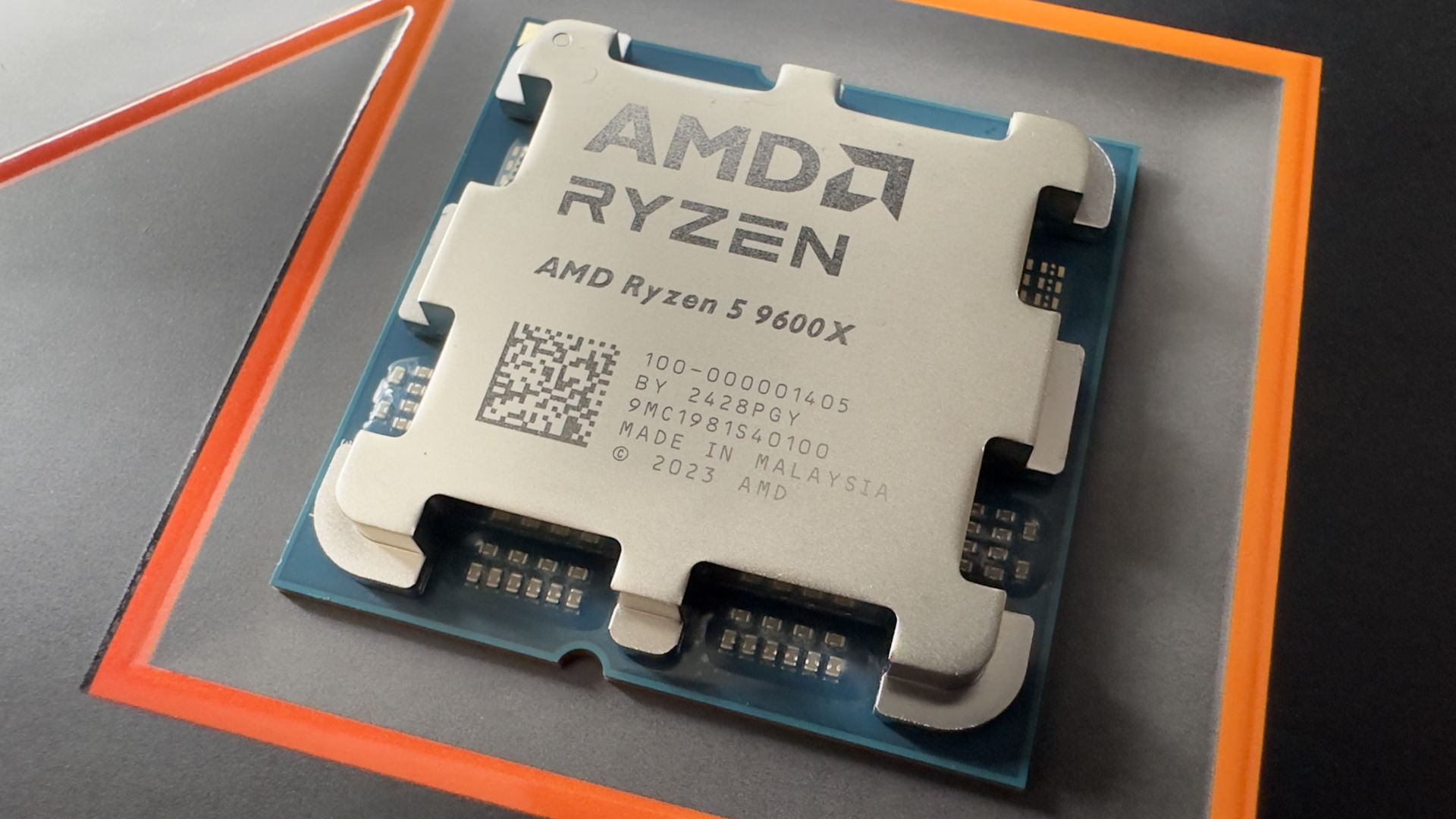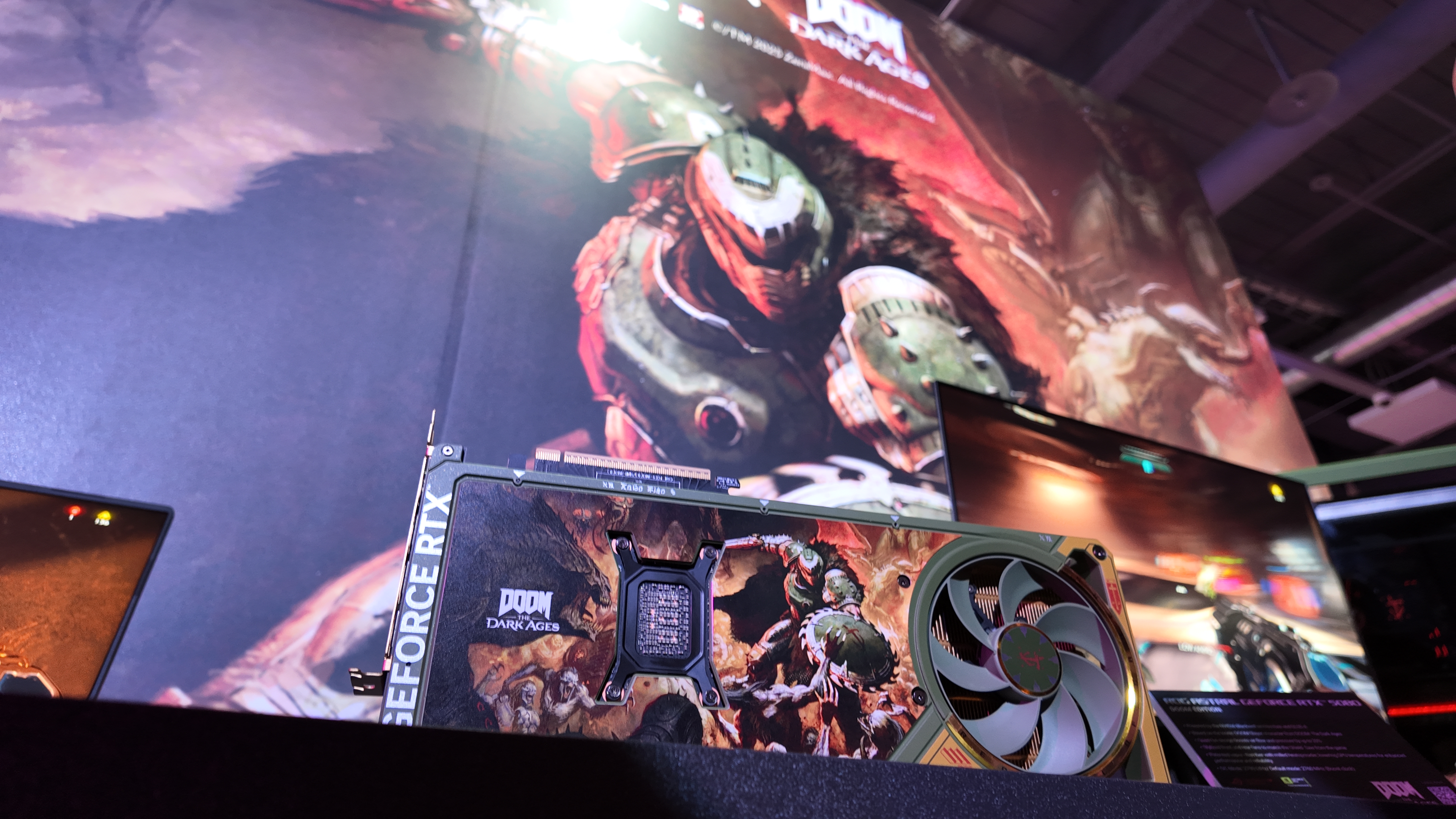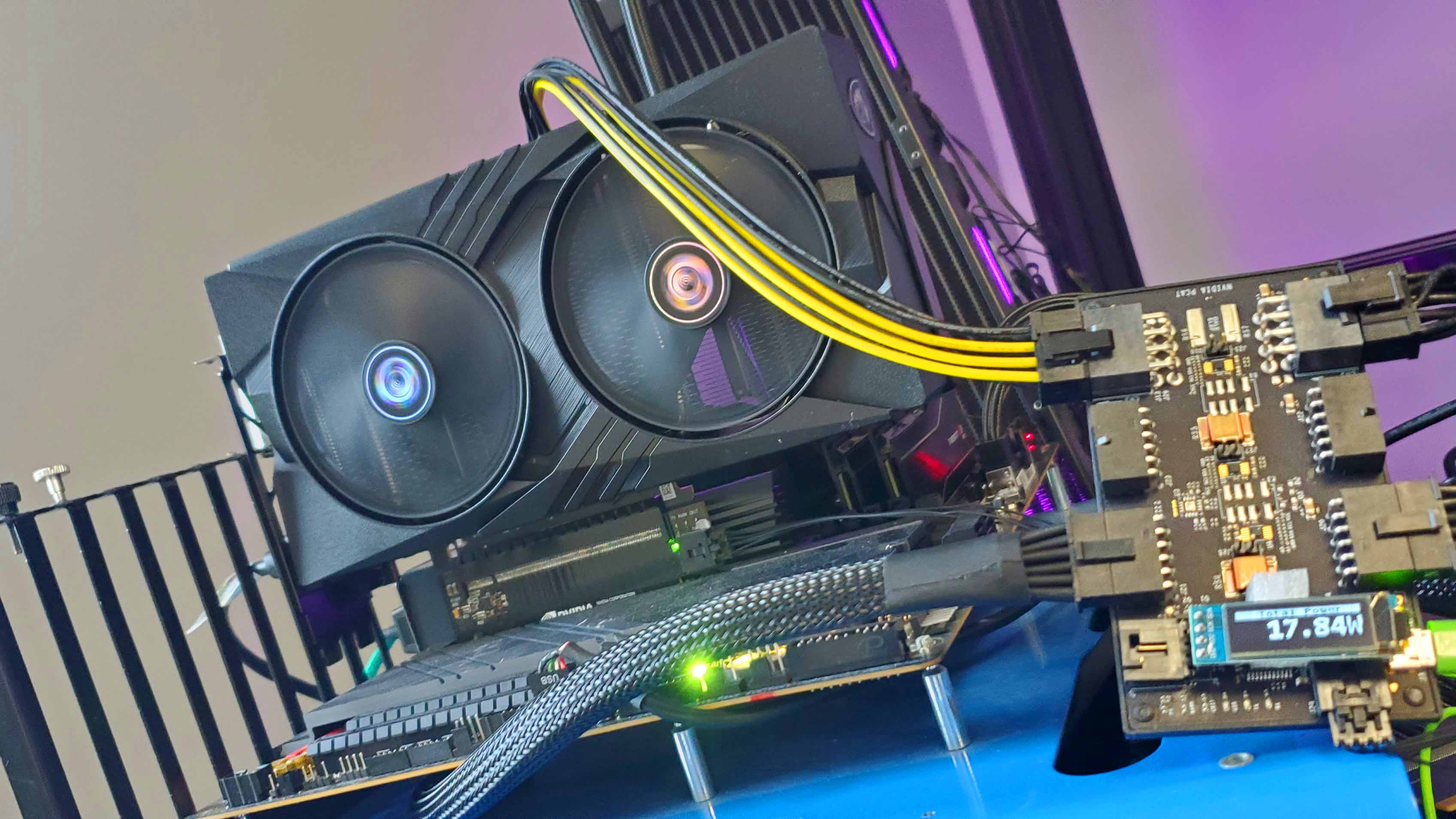
Ding, ding! Round one of the desktop Ryzen 9000 series throws six Zen 5 cores at PC gaming.
It’s taken a while to get here—and it’s honestly been a pretty bumpy road, too—but I’m pleased to present our review of the AMD Ryzen 5 9600X, the lowest-tier CPU currently on offer in AMD’s Ryzen 9000 series family of Zen 5 processors. I’m not talking about the rocky situation where AMD recalled all stocks of the new Ryzen chips weeks before they were due to be sold, either—no, this is all about jumping around motherboards, updating firmware, and endlessly fiddling about with settings. All for what is actually a somewhat underwhelming new six-core CPU.
Anyway, let’s just get down to specs business. The Ryzen 5 9600X is essentially a refreshed Ryzen 5 7600X, as it doesn’t have any more cores or threads, there’s no extra L3 cache, and even the boost clocks are barely any different. The only specs that are notably disparate are the base clocks (3.9 vs 4.7 GHz) and the TDPs (65 vs 105 W).
Deep down in the single CCD (Core Complex Die) chiplet, it’s a very different story, as AMD has comprehensively changed all kinds of aspects of the architecture, with more L1 data cache, more L2 cache bandwidth, and much better vector and branch prediction units just being a few of them.
As we’ve already gone through the AMD Zen 5 architecture in detail, I won’t reiterate it all for this review. It suffices to say that AMD has changed a lot, though time will tell if all those changes were really worth doing.
(Image credit: Future)
Cores: 6
Threads: 12
Base clock: 3.9 GHz
Boost clock: 5.4 GHz
L3 Cache: 32 MB
L2 Cache: 6 MB
Unlocked: Yes
Max PCIe lanes: 24
Graphics: Radeon Graphics
Memory support (up to): DDR5-5800
Processor Base Power (W): 65
Maximum Package Power (W): 88
Recommended customer price: $279/£269.99
One important change that is worth mentioning is the fact that the CCDs, packed with 8.6 billion transistors, are now manufactured on TSMC’s N4 process node—previously AMD used N5 and the newer fabrication method has much better transistor density and power demand.
And it’s the latter that’s the biggest improvement in the Ryzen 5 9600X, in my opinion. No matter what you throw at the little chip—sorry, chiplets—the entire package will rarely consume more than 88 W and routinely uses much less than this in games.
Keeping it cool is a doddle and while admittedly I was using an Asus ROG Strix LC III 360 mm AIO cooler for my main test rig, I briefly tried a smaller AIO and a cheap twin 120 mm air cooler.
Giving it as serious a heat test as possible (multiple AVX-512 runs), the 9600X never exceeded 75°C with any of the coolers. In the heat of my office, it was a blessed relief not to have a CPU belch out hundreds of watts.
(Image credit: Future)
(Image credit: Future)
(Image credit: Future)
Of course, all of this would be for nought if the Ryzen 5 9600X didn’t perform especially well. The good news is that it’s really good for a little six-core processor, albeit with one important caveat. I initially tested the new Zen 5 chips on an Asus ROG Strix B650-A Gaming motherboard, using its latest 3014 BIOS, which has full support for all Ryzen 9000 series CPUs.
AMD, however, recommended all reviews should be conducted on X670E boards and provided an updated, beta BIOS for a couple of models. Asus stepped in with a rapid rescue in the form of a ROG Crosshair X670E Hero and I was back in business. Except I wasn’t because it wouldn’t boot with 9600X installed. The handy BIOS flashback feature (where you can update the firmware without needing to fire up your PC) solved that problem.
It took a while longer to get everything else updated, settled, and running smoothly, but at the end of it all, I can confirm three things: (1) The Ryzen 5 9600X performs just as well in a B650 motherboard as it does in an X670E one, (2) the idle temperature was surprisingly high (around the 50 °C mark), regardless of cooler, and (3) the outright multithreaded performance was a little lower than expected.
After discussing this with AMD and checking figures with and without EXPO enabled (i.e. using the RAM at 4800 MT/s instead of 6000 MT/s), it seems that my specific configuration of hardware, BIOS, and Windows is giving the chip a little bit too much power, hence the idle figures—instead of dropping all the way down to 20 W, my setup only went down to around 27 W.
It’s also the most likely cause of the heavy multithreaded application performance, with the CPU not quite getting the right share of the total power budget. If the latter is super important to you, then you might want to hold off getting a Zen 5 chip until all the niggles are sorted out.
We’ve updated our CPU benchmarking suite for 2024, changing some of the older games for newer, more CPU-heavy ones, as well as including more productivity tests. In the case of Cyberpunk 2077, we’re using DLSS Balanced with the RT Ultra preset, to ensure that the test isn’t GPU-limited but the CPU still has the full ray tracing workload (mostly building the BVH acceleration structures). We’ve also switched from using a GeForce RTX 3080, as the supporting GPU, to an RTX 4070 to show the relative CPU performance in a more real-world light.
(Image credit: Future)
(Image credit: Future)
For testing, we ran the Ryzen 5 5600X and Ryzen 5 7600X through the new suite, along with a Ryzen 7 5700X3D, to show what difference the extra L3 cache makes, and a 65 W Ryzen 7 7900, to emphasise how total core count matters in some applications.
As for Intel chips, there are really only two that matter, and that’s the Core i5 14600K and Core i5 13400F. The former has a lower MSRP than the Ryzen 5 9600X but way more cores and was our top recommendation for the best all-round CPU before the whole Raptor Lake instability issue came to light. The 13400F is an Alder Lake chip and we still rate it as the best budget gaming CPU because it’s super cheap, yet still really good in games.
In Cyberpunk 2077 and Baldur’s Gate 3, the Ryzen 5 9600X is beaten by the Ryzen 7 5700X3D and Core i7 14700K, but as we move through Homeworld 3 and Metro Exodus, the new Zen 5 closes the gap to practically nothing. Warhammer III looks like it’s GPU-limited but it’s not really—it’s essentially a game engine that puts the bulk of the processing workload into one, heavy thread and it’s here where you can see the 9600X’s single-thread performance uplift help out a touch.
Compared to the 5600X and 7600X, the Ryzen 5 9600X is a decent step up in gaming performance, though you won’t necessarily see the same gap in every game and PC configuration. it naturally depends on the game. In some cases, there will be little to differentiate between them all, just as one can see in Warhammer III, whereas in others it will be like it is in our Cyberpunk 2077 and Baldur’s Gate 3 tests.
For me, though, the biggest showcase for Zen 5’s strength is Factorio—this is a game that loves 3D V-cache and it’s no surprise to see the 5700X3D handily beat everything else, but the 9600X easily took second place and by no close margin.
Outside of gaming, the Ryzen 5 9600X behaves just as you would expect a 12-thread processor to when compared to others supporting 16 or more. But that single core result in Cinebench proves that the baby of the Zen 5 family is surprisingly good for certain productivity tasks—AMD certainly wasn’t fibbing about the IPC uplift—though the photo editing result shows that the power niggles are helping it.
✅ You want a cheap Zen 5 chip: Right now, the 9600X is the cheapest entry point into the Zen 5 ecosystem and it’s a lower bar than when Zen 4 first appeared.
✅ You don’t care about cores: The 9600X amply proves that six cores are perfectly fine for PC gaming, so why spend more cash for more cores?
❌ You need a CPU for more than just gaming: In some apps, 12 threads just aren’t enough, so if video editing or content creation is your thing, you’ll want a different CPU.
❌ You’re on a tight upgrade budget: Zen 5 is certainly fast but its predecessor isn’t slow, and the Ryzen 5 7600X and 7600 are very cheap these days.
So, what to make of the Ryzen 5 9600X? The architectural changes implemented in Zen 5 are very welcome but they’re not going to universally improve how fast every game, application, and task runs. AMD hasn’t increased the L3 cache, core count, or greatly boosted clock speeds in the 9600X compared to the 7600X, so the performance difference between the two is always going to be very application-specific.
In games, the current babe of the Zen 5 family is no slouch and provides ample evidence that six-core chips are still perfectly fine for PC gaming. Even the productivity benchmarks are encouraging, provided one accepts that 12 threads are never really enough for rendering, video editing, etc.
And yet, despite all this, I feel a little unenthusiastic about the 9600X, which surprises me, as I have a real soft spot for the 5600X. I did have higher expectations of the Ryzen 5 9600X, coming into this review, even though I knew the test results weren’t going to be a gargantuan leap forward in CPU performance metrics.
Given Zen 5’s capabilities, I do feel AMD has missed a golden opportunity to really lift the Ryzen 5 segment—not through core count but via clock speeds—but then it would perhaps encroach too much on the Ryzen 7 segment, and it gets harder to really push the clock speeds of higher-tier chips, once you’re laden with the cores and chiplets.
What really matters, though, is whether it’s worth buying or not. If you’re currently using an AM4 gaming PC and you’ve been holding off upgrading, you’ll be better off sticking with a Ryzen 7000 series chip as opposed to a new Zen 5 one if you’re on a tight budget.
The Ryzen 5 9600X’s launch price of $279/£269.99 is very decent but you can buy the Zen 4-powered Ryzen 7 7600X for $199 right now and it’s not massively slower compared to its successor. On the other hand, if you find a prebuilt PC with a 9600X, then by all means consider buying it—you won’t regret it for one moment once you start playing games.
Overall, then, the Ryzen 5 9600X isn’t a fantastic entry point for the Ryzen 9000 series but it’s not a bad one either. And I think it’s exactly this as to why I’m a bit underwhelmed.






